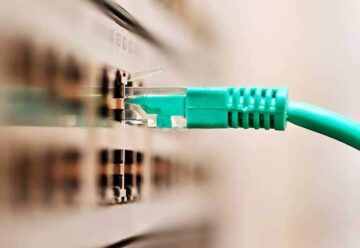10 Gigabit Ethernet is an ultrafast business Ethernet service that provides reliable, low latency connectivity. We explain 10 Gigabit Ethernet, how it differs from other Ethernet services and how it could benefit your business.
Get high-bandwidth business Ethernet
What is Gigabit Ethernet?
Gigabit Ethernet is a networking technology based on Ethernet standards that provides data transfer rates up to 1 billion bits per second, or 1 gigabit per second (1Gbps).
Standardised by the IEEE (Institute of Electrical and Electronics Engineers) in 1999, Gigabit Ethernet is an evolution of Fast Ethernet, which delivers speeds of 10 or 100 megabits per second (Mbps). It works over copper-based cables or fibre optic cables.
As Gigabit Ethernet is fully compatible with earlier Ethernet standards, it’s often deployed in enterprise backbone networks serving 10/100 Mbps local area networks (LANs).
What is 10 Gigabit Ethernet?
10 Gigabit Ethernet – also known as 10GbE, 10GE, or 10G Ethernet – is a networking standard that offers data speeds up to 10 billion bits per second (10Gbps).
Released in 2002, 10 Gigabit Ethernet offers significantly higher data transfer speeds than Fast Ethernet (100Mbps) or Gigabit Ethernet (1Gpbs). Like Gigabit Ethernet, 10GbE can run over fibre optic or copper cables.
With its higher bandwidth and lower latency, 10GbE is being widely adopted in enterprise LANs and wide area networks (WANs) to address the growing data demands of artificial intelligence (AI), 5G, and IoT.
What is the difference between 10Gb Ethernet and 1Gb Ethernet?
10Gb Ethernet differs from 1Gb Ethernet in its data transfer speed, use cases, implementation and cost:
- Speed: 10GbE provides up to ten times faster data transfer speeds than 1GbE. 10GbE takes advantage of the full-duplex protocol, meaning it can transmit up to 10Gbps of data in both directions simultaneously.
- Use cases: 1GbE is used in various scenarios, from home networks to business environments. By contrast, 10GbE is typically used in high-performance enterprise applications like data centres, storage area networks and cloud computing infrastructure.
- Implementation: 1GbE commonly uses Category 5e twisted-pair copper cables for connections up to 100 metres and fibre optic cables over longer distances. 10GbE typically uses Category 6 or 6A short-distance cables, fibre cabling for longer distances, and 10GbE-capable switches, network interface cards, and routers.
- Cost: 1GbE hardware tends to be cheaper than 10GbE equipment because it’s less sophisticated. However, the cost difference between the two is narrowing as technology improves.
Despite its significantly better performance, 10GbE remains fully interoperable with 1GbE and earlier Ethernet standards.
10GbE-enabled router showing 1G and 10G Ethernet ports

How does 10 Gigabit Ethernet work?
10 Gigabit Ethernet operates like other Ethernet services, using a similar format of frames and packets to transmit data. That’s why it’s fully compatible with traditional Ethernet and easy to integrate into existing networks. However, there are significant differences between 10GbE and traditional Ethernet.
First, 10 Gigabit Ethernet achieves a higher data transmission rate by encoding and modulating data differently, depending on the type of cabling used.
Second, 10GbE is designed to operate in full-duplex mode only. That means it simultaneously transmits data in both directions on one channel, improving network efficiency and reducing latency.
Like 1Gbps Ethernet, 10GbE can use various types of fibre optic or copper cabling, depending on the purpose and reach of the network.
Get high-bandwidth business Ethernet
Types of 10 Gigabit Ethernet
The IEEE has introduced various 10 Gigabit Ethernet standards for LANs, WANs and other applications over different distances. Copper-based cables can be used for connections up to 100 metres. For longer distances, 10GbE uses:
- Multimode fibre, which divides the light signal into multiple paths for different channels, with a range of up to 300 metres
- Single-mode fibre, featuring a single path, suitable for longer distances up to 40km (25 miles) or more
Here are some common 10 Gigabit Ethernet standards in order of maximum reach.
Common types of 10 Gigabit Ethernet
| Name | IEEE standard | Cable | Max distance |
| 10GBASE-CX4 | 802.3ak-2004 | Copper (twinaxial) | 15m |
| 10GBASE-T | 802.3an-2006 | Copper (twisted pair) | 100m |
| 10GBASE-LRM | 802.3aq-2006 | Fibre (multimode) | 220m |
| 10GBASE-SR/SW (for LAN/WAN) |
802.3ae-2002 | Fibre (multimode) | 300m |
| 10GBASE-LR/LW (for LAN/WAN) |
802.3ae-2002 | Fibre (single mode) | 10km (6 miles) |
| 10GBASE-ER/EW (for LAN/WAN) |
802.3ae-2002 | Fibre (single mode) |
40km (25 miles) |
In addition to IEEE standards, several manufacturers offer proprietary 10GbE types, such as 10GBASE-ZR/ZW, with a maximum range of 80km (50 miles).
What are the benefits of 10GbE?
Many advanced computers and mobile devices can now read files at speeds of 10Gbps. However, when numerous devices connect and share data over your network, bottlenecks may occur.
10 Gigabit Ethernet solves this problem. With 10GbE, you can achieve speeds up to 10Gbps for content downloads or uploads.
While it may cost more than 1GbE to implement, the benefits can more than offset the expense. With 10GbE, you can:
- Prevent data bottlenecks even when multiple computers share bandwidth in a server cluster
- Boost employee productivity with a more stable connection, eliminating interruptions and delays
- Improve customer response times, especially when many customers and employees are connected at the same time
- Simplify your IT by increasing your connection speeds using one server instead of combining multiple Gigabit Ethernet ports
- Strengthen your security with a fully contained fibre network that requires physical access to the router
Overall, 10 Gigabit Ethernet provides much higher bandwidth and lower latency than 1GbE, making it suitable for data-hungry enterprise applications.
What is 10 Gigabit Ethernet used for?
10 Gigabit Ethernet is used in various business applications where high speed and low latency are critical, including:
- Data centres: interconnecting data centres, servers, storage systems and networking equipment
- Network service providers: enabling backbone networks and ensuring reliable services for customers
- Cloud computing: connecting cloud environments and providing virtual services
- Banking and financial services: enabling real-time trading transactions and reliable customer service
- Media and entertainment: handling large files for video and other content creation
- Education and research: connecting universities and research organisations for collaboration and data sharing
Whatever your business, a 1Gbps Ethernet connection can lead to bottlenecks. For example, when 100 devices share a 1GbE connection, each is limited to 10Mbps throughput, which can slow down or interrupt connections.
That’s why many UK businesses are turning to 10GbE to meet the increasing bandwidth demands of cloud computing, AI, 5G, and IoT.
Do you need 10 Gigabit Ethernet?
Whether 10 Gigabit Ethernet is right for you depends on your needs and budget. If you’re a data centre business, network service provider, or operating in data-heavy industries like financial services, media, online retail or health care, then 10GbE may be an ideal solution.
At Neos Networks, we offer a range of scalable, high-performance Business Ethernet services to suit your business, from 10Mbps to 100Gbps.
If you’d like to discuss how best to boost your connectivity, get in touch. We’ll be happy to supercharge your network for the future.








